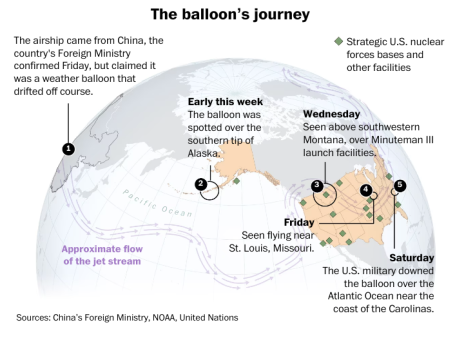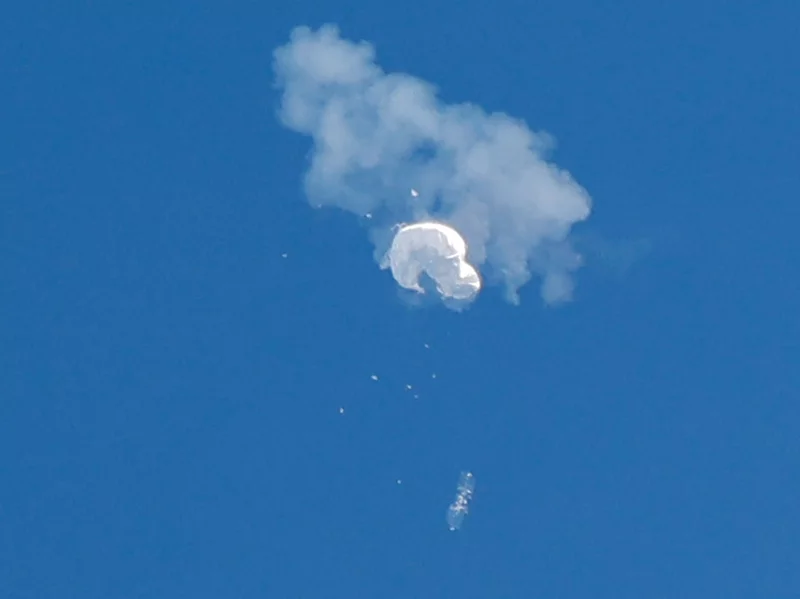Chinese Balloon Shot Down over the coast of South Carolina
The Chinese spy balloon drifts to the ocean after being shot down.
February 9, 2023
The U.S. government tracked a spy balloon believed to be from China as it entered U.S. airspace on Saturday, January 28th. The balloon was the size of 3 large buses, and one official said that it contained “some sophisticated communications gear.”
Here is a brief timeline of events regarding the balloon:
On January 28th, the balloon entered U.S. airspace as it flew over the southern tip of Alaska and the Aleutian islands. During this time, U.S. officials had not publicly acknowledged the balloon.
Then, on January 30th, the balloon entered Canadian airspace.
Next, on Tuesday, January 31, the balloon re-entered U.S. airspace over Northern Idaho. This is when officials first considered shooting down the balloon but ultimately decided not to as they didn’t want to harm anyone on the ground.
The next day, Wednesday, February 1st the balloon flew over Montana and close to Malmstrom air force base, which has many nuclear missile silos. In addition, Billings Logan International Airport temporarily shut down and stopped flights as the balloon flew overhead. On this same day, President Biden authorized a takedown of the balloon and Defense Secretary Lloyd Austin would say later in a statement that the takedown would occur, “as soon as the mission could be accomplished without undue risk to American lives under the balloon’s path.” While the balloon was over Montana, it was spotted by many civilians, including Chase Doak, who recorded the balloon.
On Thursday, February 2nd, U.S. officials announced that the balloon had been flying over the U.S. for several days now. Pentagon spokesman, Brig. Gen. Patrick Ryder told the media that the balloon was, “well above commercial air traffic and does not present a military or physical threat to people on the ground.”
Then on Friday, February 3rd, civilians spotted the balloon again as it floated over Kansas and Missouri. China’s foreign ministry then said that the “airship” was a weather balloon that had floated off course due to the westerly winds and limited control of the vessel. They also added that “China regrets that the airship strayed into the United States by mistake.” On Friday night, the Pentagon had seen reports of a second balloon that was traveling over Latin America, and it too was suspected to be a Chinese surveillance balloon. Many social media users in Costa Rica posted videos and images of an unmarked hot air balloon flying over the country.
Finally, on Saturday, February 4th, the balloon was shot down by the U.S. military as it floated over the Atlantic Ocean off the coast of South Carolina. The Federal Aviation Administration also ordered ground stops for all flights out of Wilmington (N.C.), Myrtle Beach (S.C.), and Charleston (S.C.).

Air Balloon History
Spy balloons are not new technology as they were even used during the Civil War. During the Civil War, the Union used hot-air balloons to spy on and track Confederate troops. Balloons were also used in World War I by the photographic section of the U.S. Army Air Service. They used the balloons to conduct surveillance and get aerial images. And not long after in the 1950s, the U.S. Air Force started Project Genetrix, as a “large-scale, unmanned, high altitude balloon intelligence operation” which had the goal of taking photos of Soviet land. And recently balloon surveillance has continued, as Chinese surveillance balloons have been spotted multiple times over the last five years in the Pacific, including over Hawai’i.
Controversy Over the Balloon
Some Republicans criticized Biden and his administration for not shooting down the balloon earlier. They said that he was easily intimidated by China and too slow to defend the U.S. and its land. And fuel was only added to the fire after Secretary of State Antony Blinken canceled his trip to China as the balloon situation intensified.
In addition, China also accused the United States of overreacting to the situation, trying to reiterate its claims that it was a civilian vessel that had drifted off course. They added that downing the balloon “seriously impacted and damaged both sides’ efforts and progress in stabilizing Sino-U.S. relations.”
Many also say this event represents a larger “cold-war” conflict between the two superpowers of the U.S. and China as they rival each other. The balloon created a realization that the threat of China was not distant and unseen as before.






